2020 MERCEDES-BENZ C-CLASS SEDAN weight
[x] Cancel search: weightPage 46 of 546
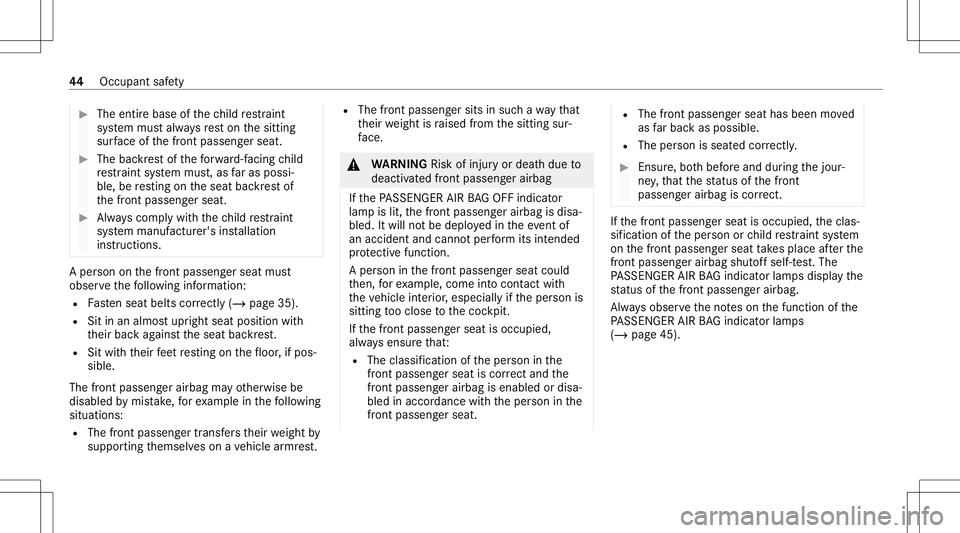
#
The entir ebase ofthech ild restra int
sy stem mus talw aysre st on thesitt ing
sur face ofthefront passeng erseat. #
The backres tof thefo rw ard-f acin gch ild
re stra int system mus t,as faras possi ‐
ble, beresting ontheseat backres tof
th efront passeng erseat. #
Alw ayscom plywit hth ech ild restra int
sy stem manuf acturer'sinstallation
ins truct ions . A
per son onthefront passeng erseat must
obser vethefo llo wing informatio n:
R Fasten seat belts correctl y(/ page 35).
R Sitinan almos tupr ight seatposi tion with
th eir bac kag ains tth eseat backres t.
R Sitwithth eir feet resting onthefloor ,if pos‐
sible.
The front passeng erairbag mayot her wise be
disabl edbymis take ,fo rex am ple inthefo llo wing
situat ions:
R The front passen gertr ansf ersth eir weight by
suppor tingthemselv eson ave hicle armr est. R
The front passeng ersits insuc hawa yth at
th eir weight israised from thesitt ing sur‐
fa ce. &
WARNIN GRisk ofinju ryor deat hdue to
deactiv ated front passeng erairbag
If th ePA SSENGER AIRBAGOF Find icat or
lam pis lit,th efront passeng erairbag isdisa‐
bled. Itwill notbe deplo yedin theeve ntof
an acci dent and canno tpe rfor m its intended
pr otect ive func tion.
A per son inthefront passeng erseat could
th en, forex am ple, com eint ocon tact with
th eve hicle interior ,especially ifth eper son is
sitt ing tooclose tothecoc kpit.
If th efront passeng erseat isoccupied,
alw aysensur eth at:
R The classificat ion oftheper son inthe
fr ont passeng ersea tis cor rect and the
fr ont passeng erairb agisenabl edordisa ‐
ble din accordance withth eper son inthe
fr ont passeng ersea t. R
The front passeng ersea thas been moved
as farbac kas possi ble.
R The person isseat edcor rectl y. #
Ensu re,bo th bef oreand during thejour‐
ne y,that thest atus ofthefront
passeng erairbag iscor rect. If
th efront passeng erseat isoccupied, theclas‐
sif ication oftheper son orchild restra int system
on thefront passeng erseat take splace afte rth e
fr ont passeng erairb agshut offself-t est.The
PA SSENGER AIRBAGind icat orlam psdispl aythe
st atus ofthefront passeng erairbag.
Alw aysobser vetheno teson thefunc tion ofthe
PA SSENGER AIRBAGind icat orlam ps
(/ page45). 44
Occupant safety
Page 52 of 546
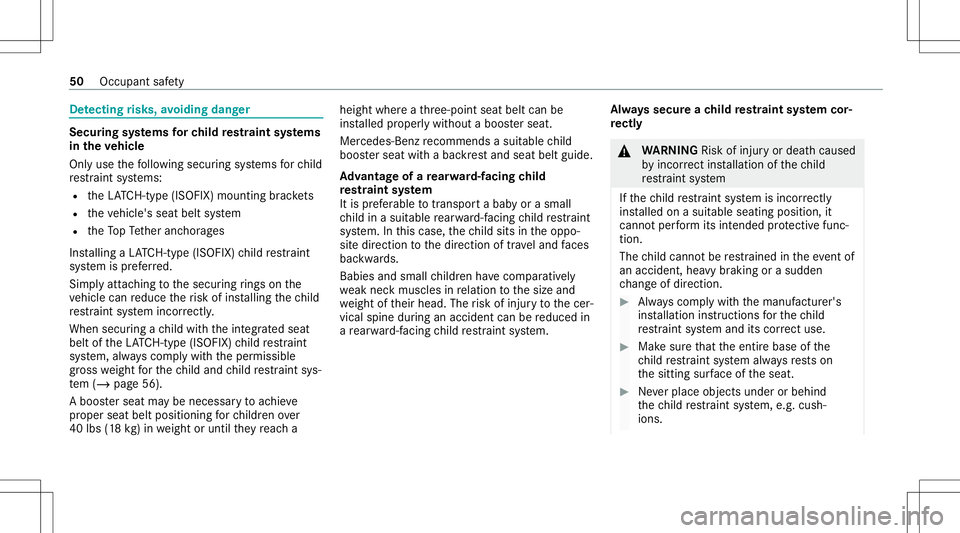
De
tectin grisk s,avo iding danger Secur
ingsystems forch ild restra int systems
in theve hicl e
Only usethefo llo wing secur ingsystems forch ild
re stra int systems:
R theLA TC H-type (ISOFIX )mou nting brac kets
R theve hicle's seatbeltsystem
R theTo pTe ther anc horages
Ins talling aLA TC H-type (ISOFIX )ch ild restra int
sy stem isprefer red.
Sim plyattaching tothesecur ingrings onthe
ve hicle canreduce therisk ofins talling thech ild
re stra int system incor rectly .
Whe nsecu ring ach ild withth eint egr ated seat
belt oftheLA TC H-type (ISOFIX )ch ild restra int
sy stem, alwayscom plywit hth eper missible
gr oss weight forth ech ild and child restra int sys‐
te m (/ page56).
A boos terseat maybe necessar yto achie ve
pr oper seatbeltposition ingforch ildr enove r
40 lbs (18 kg )in we ight orunt ilth ey reac ha heigh
twher eath re e-point seatbeltcanbe
ins talled proper lywit hout aboos terseat.
Mer cedes-Benz recomme ndsasu itab lech ild
boos terseat withabac kres tand seat beltguide.
Ad vantag eof are ar wa rd-faci ng child
re stra int system
It is prefer able totrans portabab yor asmall
ch ild inasuit able rear wa rd-faci ng child restra int
sy stem. Inthis case, thech ild sits intheoppo‐
sit edir ect ion tothedir ect ion oftrave land faces
ba ckwa rds.
Babies andsmall childr enhave com parativ ely
we ak nec kmusc lesinrelation tothesize and
we ight oftheir head. Therisk ofinjur yto thecer‐
vical spine during anacciden tcan bereduced in
a re ar wa rd-faci ng child restra int system. Alw
ayssecur each ild restra int system cor‐
re ctl y &
WARNIN GRisk ofinju ryor deat hcaused
by inc orrect ins tallation ofthech ild
re stra int system
If th ech ild restra int system isincor rectly
ins talled onasuit able seatin gposit ion,it
can notper form itsintended protect ive func ‐
tion .
The child can notbe restra ined intheeve ntof
an acci dent, hea vybraki ng orasu dd en
ch ang eof dir ect ion. #
Alw ayscom plywit hth emanuf acturer's
ins tallation instruct ions forth ech ild
re stra int system and itscor rect use. #
Makesur eth at theent ire base ofthe
ch ild restra int system alwaysre stson
th esitt ing surface oftheseat. #
Neverpla ceobjects underorbehi nd
th ech ild restra int system, e.g.cush‐
ions. 50
Occupant safety
Page 108 of 546
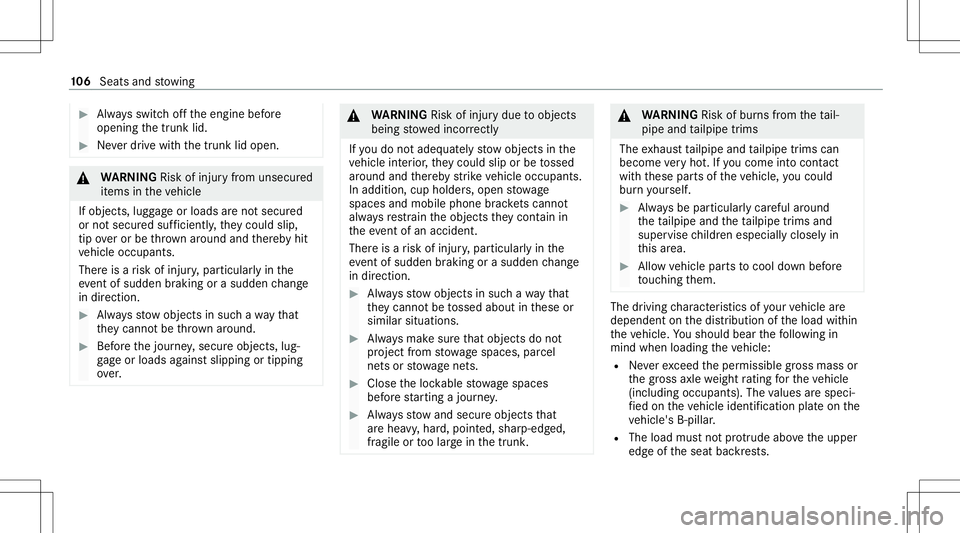
#
Alw aysswitc hof fth eengine before
opening thetrunk lid. #
Neverdr ive wit hth etrunk lidopen. &
WARNIN GRisk ofinju ryfrom unsecu red
it ems intheve hicle
If object s,lugg ageor loads areno tsecur ed
or notsecur edsuf ficie ntly,they cou ldslip,
tip ove ror be throw nar ou nd and ther eb yhit
ve hicle occupants.
Ther eis arisk ofinjur y,par ticular lyin the
ev ent ofsudden braking orasudden chang e
in dir ect ion. #
Alw aysst ow object sin suc hawa yth at
th ey canno tbe thro wn around . #
Beforeth ejour ney,secur eobjects, lug‐
ga ge orloads agains tslipping ortipping
ove r. &
WARNIN GRisk ofinju rydue toobject s
being stowe dincor rectl y
If yo udo notadeq uatelyst ow object sin the
ve hicle interior ,th ey cou ldslipor be tossed
ar ound andther eb yst rike vehicle occupants.
In addition, cupholder s,open stow age
spac esand mobi lephon ebr ac kets cann ot
alw aysre stra in theobjec tsthey cont ain in
th eev ent ofan acciden t.
Ther eis arisk ofinjur y,par ticular lyin the
ev ent ofsudden braking orasudden chang e
in dir ect ion. #
Alw aysst ow object sin suc hawa yth at
th ey canno tbe tossed about inthese or
similar situation s. #
Alw aysmak esur eth at obj ect sdo not
pr oject from stow agespac es,parcel
ne ts or stow agene ts. #
Close theloc kable stow agespac es
bef orest ar tin gajo ur ne y. #
Alw aysst ow and secureobj ect sth at
ar ehea vy,har d,poin ted, shar p-edg ed,
fr agile ortoolarg ein thetrunk . &
WARNIN GRisk ofburnsfrom theta il‐
pipe andtailpipe trims
The exhaus tta ilpipe andtailpipe trims can
becom eve ry hot.Ifyo uco me intoco ntact
wit hth ese partsof theve hicle, youco uld
bur nyo urself . #
Alw aysbe par ticular lycareful arou nd
th eta ilpipe andtheta ilpipe trims and
super visechildr enespec iallycloselyin
th is area. #
Allo wvehicle partsto cool down before
to uc hin gth em. The
driving charact eristic sof your vehicle are
dependent onthedis tribution oftheload within
th eve hicle. Yousho uld bear thefo llo wing in
min dwhen loading theve hicle:
R Neverex ceed theper missible gross mass or
th egr oss axle weight rating forth eve hicle
(including occupants). Thevalues arespec i‐
fi ed on theve hicle identif ication plateon the
ve hicle's B-pillar.
R The load mustno tpr otru de abo vetheupper
edg eof theseat backres ts. 10
6
Sea tsand stow ing
Page 117 of 546

#
Toremo ve:sl id e catc h2 forw ards and pull
out cup holde r1. #
Toins tall: inser tcup holder 1and slide
bac kcat ch2.
% The cup holder rubber matcanberemo ved
fo rclea ning, e.g.using clea n,luk ewa rm
wa ter. Opening
orclosing thecup hold erinthere ar
ar mr est *
NO
TEDama getothere ar armr estdue to
body weight When
folded out,there ar armr estcan be
damag edbybody weight . #
Donotsit orsuppor tyo urself onthe
re ar seat armr est. *
NO
TEDama getothecup holder When
there ar armr estis folded backth ecup
holder couldbecome damaged. #
Onlyfo ld there ar armr estbac kwhen
th ecup holder isclosed. #
Toopen: press cup holder 1or2.
Cup holder 1or2 extends automatical ly. #
Toclose: pushcupholde r1 or2 bac k
unt ilit eng ages. Asht
rayand cigarette light er Using
theash tray inthefront cent erconsole *
NO
TEDama getothestow agecom part‐
men tunde rth eashtr aydue tointens e
heat The
stow agecom partment unde rth eashtra y
is no theat resis tant and couldbe dama gedif
yo ure st alit cig arette on it. #
Mak esur eth at theashtr ayisfull y
eng aged. Seat
sand stow ing 11
5
Page 389 of 546

*
NO
TEDama gedue totowing away at
exc essiv elyhigh speeds orove rlong dis‐
ta nces The
drivet ra in could bedamag edwhen tow‐
ing atexc essiv elyhigh speeds orover long
dis tances. #
Atowing speed of30 mph(50 km/h)
mus tno tbe exc eeded. #
Atowing distan ceof30 miles(50 km)
mus tno tbe exc eeded. &
WARNIN GRisk ofacci dent whento wing
a ve hicle whichis toohea vy
If th eve hicle being tow- star tedor towe d
aw ay ishea vier than theper missible gross
mass ofyour vehicle, thefo llo wing situat ions
can occur:
R The towing eyema ybecome detach ed.
R The vehicle/tr ailercombination may
sw erve oreve nov ertur n. #
Ifano ther vehicle istow- star tedor
to we daw ay,its weight mustno texc eed th
eper missible gross mass ofyour ow n
ve hicle. If
ave hicle mustbe tow- star tedor towe daw ay,
its per missib legross weight mustno texc eed the
per missible gross weight oftheto wing vehicle. #
Information ontheper missible gross mass of
th eve hicle canbefound ontheve hicle iden‐
tif ication plate(/ page428). #
Vehicl eswith automatic transmiss ion:Do
no topen thedr iver's door orfront passeng er
door ,ot her wise theaut omatic transmiss ion
aut omaticall yshif tsto position 005D. #
Installth eto wing eye(/ page389). #
Fasten theto w bar .
* NO
TEDama gedue toinc orrect connec‐
tion oftheto w bar #
Onlyconnect theto w rope ortow bar to
th eto wing eyes. #
Deact ivat eth eaut omatic locking mechanism
(/ page72 ). #
Donotactiv ateth eHOLD function. #
Deact ivat eth eto w- aw ay alar m(/ page91 ). #
Deac tivateAc tiveBr ak eAssi st
( / pag e18 1). #
Vehicl eswith automatic transmiss ion:
Shif tth eaut omatic transmiss iontoposition
005C. #
Release theelectr icpar king brak e. &
WARNIN GRisk ofacci dent dueto limi‐
te dsaf ety-re lat ed func tionsdur ing the
to wing proce ss
Saf ety-re lat ed func tionsar elimit edorno lon‐
ge rav ailable inthefo llo wing situat ions:
R theignition isswitc hedoff.
R thebr ak esy stem orpowe rst eer ing sys‐
te m ismalfu nctioning.
R theener gysupply ortheon- boar delectr i‐
cal system ismalfunct ioning.
When your vehicle isthen towe daw ay,signif ‐
icant lymor eef fort ma ybe requ ired tosteer
and brak eth an isno rm allyre qu ired. Br
eakdo wnassis tance 38
7
Page 405 of 546
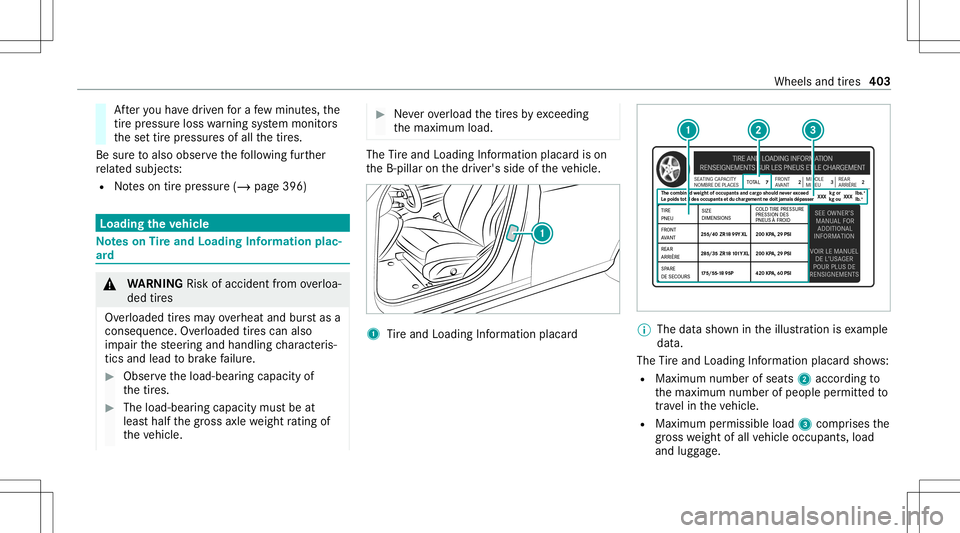
Af
teryo uha ve driven fora fe w min utes, the
tir epr es su re loss warning system monit ors
th ese ttir epr essur esofall thetir es.
Be sureto also obse rveth efo llo wing further
re lat ed subje cts:
R Noteson tirepr essur e(/ page396) Loading
theve hicl e No
teson Tire and Loading Information plac‐
ar d &
WARNIN GRisk ofacci dent from overloa‐
ded tires
Ov erloaded tires ma yov erheat andburstas a
con sequenc e.Ov erloaded tires can also
im pair thesteer ing and handling charact eris‐
tic sand lead tobrak efa ilur e. #
Obser vetheload-bear ingcapacity of
th etir es. #
The load-bear ingcapacity mustbe at
leas thalf thegr oss axle weight rating of
th eve hicle. #
Neverove rload thetir es by exc eeding
th emaximum load. The
Tire and Loadi ngInfo rm atio nplacar dis on
th eB-pillar onthedr iver's side oftheve hicle. 1
Tire and Loadi ngInfo rm atio nplacar d %
The datasho wnintheillus tration isexam ple
dat a.
The Tire and Loadi ngInfo rm atio nplacar dsho ws:
R Maximum numberofseats 2accor dingto
th emaximum numberofpeople permitt edto
tr ave lin theve hicle.
R Maximum permissible load3com prises the
gr os swe ight ofall vehicle occupants, load
and luggage. Wheels
andtires 403
Page 406 of 546
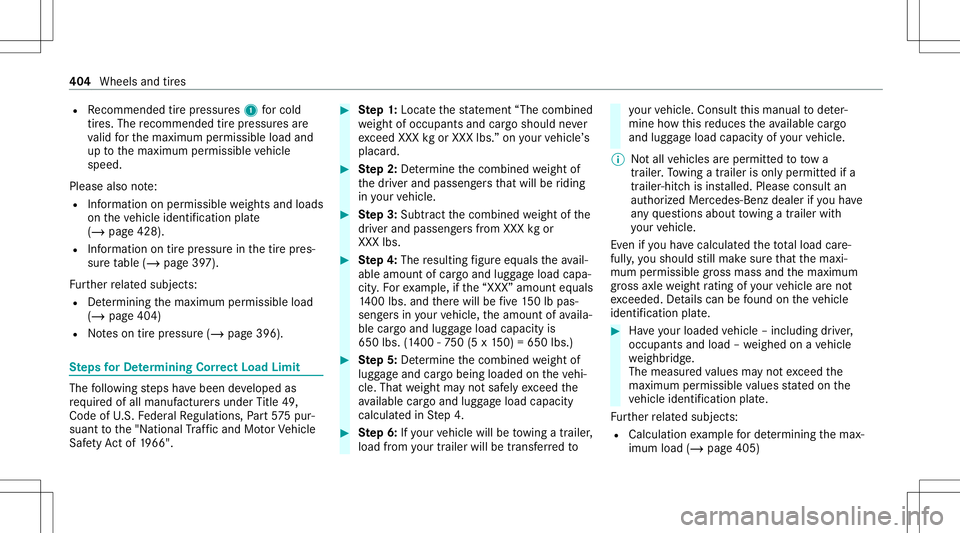
R
Recomme ndedtirepr ess ures 1 forcold
tir es. The recomme ndedtirepr ess ures are
va lid forth emaximum permissible loadand
up tothemaximum permissible vehicle
speed.
Please alsonote:
R Information onper missib lewe ight sand loads
on theve hicle identif ication plate
(/ page428).
R Information ontirepr essur ein thetir epr es‐
sur eta ble (/ page39 7).
Fu rther relat ed subje cts:
R Determ inin gth emaximum permissible load
(/ page404)
R Noteson tirepr essur e(/ page396). Ste
psforDe term ining Correct Load Limit The
follo wing steps have been developed as
re qu ired ofall manuf acturersunder Title 49,
Co de ofU.S. Feder alRe gulations, Part57 5pur‐
sua nttothe"N ational Traf fic and MotorVe hicle
Saf etyAc tof 1966". #
Ste p1: Loca tethest at emen t“T he combined
we ight ofocc upant sand cargoshould never
exc eed XXX kgorXXX lbs.”on your vehicle ’s
placar d. #
Ste p2: De term ine thecombin edweight of
th edr iver and passeng ersth at will beriding
in your vehicle. #
Ste p3: Sub tract thecombin edweight ofthe
dr iver and passeng ersfrom XXX kgor
XXX lbs. #
Ste p4: The resulting figur eeq uals theav ail‐
able amoun tof car goand luggageload capa‐
cit y.Fo rex am ple, ifth e“XXX” amount equals
14 00 lbs. and ther ewill befive 150lb pas ‐
seng ersin your vehicle, theamount ofavaila‐
ble cargoand luggageload capac ityis
65 0lbs. (140 0-75 0(5 x15 0) =650 lbs.) #
Ste p5: De term ine thecombin edweight of
lugg ageand cargobeing loaded ontheve hi‐
cle. That weight mayno tsaf elyexc eed the
av ailable cargoand luggageload capac ity
calc ulatedinStep 4. #
Ste p6: Ifyo ur vehicle willbetowing atrailer ,
load from your trailer willbetrans ferred to yo
ur vehicle. Consult this manual todeter‐
mine howthis reduces theav ailable cargo
and luggageload capac ityofyour vehicle.
% Notall vehicles areper mitt edtotow a
trailer .To wing atrailer isonl yper mittedifa
tra iler -hit chisins talled. Please consult an
aut hor ized Mercedes -Benz dealer ifyo uha ve
an yqu estion sabout towing atrailer with
yo ur vehicle.
Ev en ifyo uha ve cal cul ated thetot alload care‐
full y,yo usho uld still mak esur eth at themaxi‐
mum permissible gross mass andthemaximum
gr oss axle weight rating ofyour vehicle areno t
exc eeded. Details can befound ontheve hicle
identif ication plate. #
Have your loaded vehicle –including driver ,
occupants andload –we ighed onave hicle
we ighbr idge.
The measur edvalues mayno texc eed the
maximu mper missi blevalues stat ed on the
ve hicle identif ication plate.
Fu rther relat ed subje cts:
R Calculation exam ple forde term inin gth emax‐
imum load(/page405) 40
4
Wheels andtires
Page 407 of 546

R
Tire and Loadi ngInfo rm atio nplacar d
(/ page40 3)
R Tire pressur eta ble (/ page39 7)
R Vehicle identif ication plate Calculation
exam ple forde term ining the
ma ximum load The
follo wing table showsexam ples ofhowto
cal cul ateto ta land load capac itieswithva rying
seatin gcon figur ations anddiffere nt num bers
and sizes ofocc upant s.The follo wing exam ples
use amax imum loadof1500 lbs (680 kg).This is
forillus tratio npur pos esonly.Mak esur e
yo uar eusin gth eactual loadlimit foryo ur vehi‐
cle stat ed on your vehicle's Tire and Loadi ng
In fo rm atio nplacar d(/ page40 3).
The high erthewe ight ofall theoccupant s,the
smaller themaximum loadforlug gage .
Ste p1 Ex
am ple 1E xamp le2
Combine dmaxim umweight ofocc upant sand
load (datafrom theTire and Loadi ngInfo rm atio n
placar d) 15
00 lbs (680 kg)1 500lbs(680 kg) Ste
p2 Ex
am ple 1E xamp le2
Nu mb erofpeople intheve hicle (driver and
occupants) 51
Dis trib uti on oftheoccupant sF ront:2
Re ar:3 Fr
ont :1 Wheels
andtires 405